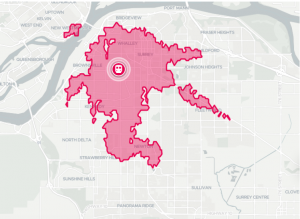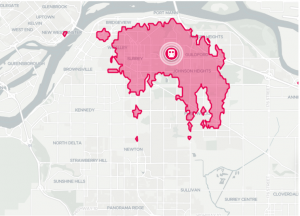My MCE analysis to determine the ideal bus terminal location ended up generating locations in the areas that I had predicted in the previous results section. I have highlighted in Figure 4 below, using black circles, those areas assigned with the most weight and therefore deemed as the most suitable for a bus terminal. From this, we can see that all communities aside from Fleetwood have regions that could support a bus terminal. However, it appears that the communities of Newton, Whalley and Guildford would be most ideal for a bus terminal since they involve regions associated with higher weights (indicated by the colour black). This can be attributed to ideal land uses and high population densities of these areas.

Figure 4. Potential location of a bus terminal determined through a weighted analysis.
Upon conducting a sensitivity analysis as seen in Figure 5, where land use and population density were assigned equal weights, there were much fewer areas that could be ideal for bus terminals. In particular there were a lot fewer areas associated with high weights (indicated by the colour black). Yet at the same time, a lot of the areas associated with lower weights (indicated by the colour red) in the weighted analysis, remained in the equal weights sensitivity analysis. I feel that conducting this analysis was very important to visualize and understand how a different normalization approach could affect the outcomes of my bus terminal location objective. It made me realize that assigning weights to factors accordingly, is important because it can in fact generate a result that is much more different and perhaps much more significant for the purposes of one’s analysis.

In order to determine the most ideal bus terminal location between these three regions, (Newton, Whalley and Guildford) I produced isochrone maps which are included below. These maps show how accessible these areas are by transit.



From these isochrone maps I was able to establish that the identified Newton location was the most ideal for locating a bus terminal as it was much more reachable by transit for those commuters that live in different regions. I came to this conclusion as it appears that there is a larger coloured area for the Newton location in comparison to the other locations in the isochrone maps.
In terms of the potential limitations of this analysis, I recognize that land use and population density are not the only relevant considerations for locating a bus terminal. There are far more factors (age groups, location of UBC commuters, areas of high ridership) to consider and therefore the location I chose is by no means perfect. Another aspect to consider here is that I did not explore other ways of choosing the most ideal location. By this, I mean that I chose to use an isochrone map highlighting reachability by transit but I could have explored reachability by walking, by car or even a general radius map to choose between the Newton, Whalley & Guildford locations.
In regards to potential errors of my analysis, it is likely that through the polygon to raster conversion there was a loss of resolution, that the data I used may not reflect current conditions/may be suppressed and therefore may render my results unreliable, and that the modifiable areal unit problem may have interfered with my results (i.e. the aggregation of population density). Despite the aforementioned limitations and errors, I feel that my analysis is a good starting point for discovering a bus terminal for a bus route from Surrey to UBC
